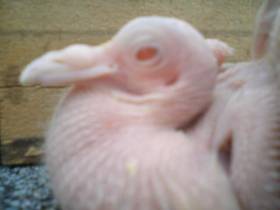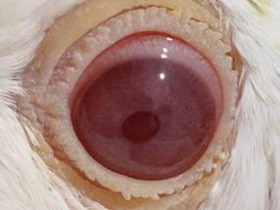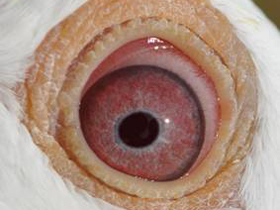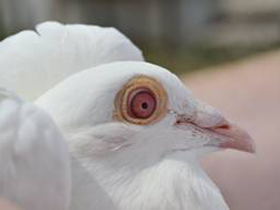
9. X-Pigeons |
||||
al - Albino
Albino is an autosomal recessive mutation. Albinism eliminates pigment production (melanin) and produces white plumage, without any form of pigmentation. The albino mutation interferes with the production of melanin, none is produced anywhere in the body. Therefore, by definition, if any pigment cells of an individual contain pigment (melanin) any part of the animal's body, it should not be considered an albino. Albinism is seen in pretty much all the animal species, including humans. In genetics, a single gene that is responsible for a variety of traits is called pleiotropy. Albinism is a pleiotropic trait where the gene for this trait not only results in the typical albino deficiency of skin, hair, and eye pigmentation but also causes defects in vision. In albinos, the pigment cells are present in the tissue, but are without any melanin forming potential.
 "The
wild type gene makes an enzyme called tyrosinase. Tyrosinase together
with oxidizers such as peroxides reacts with the amino acid
tyrosine to make melanin. So, any mutation that causes that gene to make
a tyrosinase that is ineffective is going to give you an albino. The
mutant will always be recessive as if there is one good copy the animal
will make pigment. This is one of only two color genes where we know
for sure the exact biochemistry that is happening", says Dr. Richard
Cryberg. The eye color of the albino pigeons
appear to be pink; what we see is the reflection of the light through
the blood tissue that looks like
a pink color. The
pink eye color is one of the ways we can differentiate a recessive white
pigeon from an albino pigeon. The eye color of the recessive white will
be dark
brown
(bull eyes). The bull eye is generally seen
in recessive white and pied bald whites. Albino pigeons on the other
hand, have pink eyes. Although albino pigeons have the same life expectancy
as the any other healthy pigeons, without pigment production in the eye,
albino birds often have trouble seeing in bright sunlight. In the normal
eyes and eye colors, melanin absorbs more light and the eye appears darker.
This is why, albinos usually are delicate, and because of the vision
problems, have some difficulty learning to eat and drink. Fanciers, should
help albinos during the fledgling period or they might lose them.
"The
wild type gene makes an enzyme called tyrosinase. Tyrosinase together
with oxidizers such as peroxides reacts with the amino acid
tyrosine to make melanin. So, any mutation that causes that gene to make
a tyrosinase that is ineffective is going to give you an albino. The
mutant will always be recessive as if there is one good copy the animal
will make pigment. This is one of only two color genes where we know
for sure the exact biochemistry that is happening", says Dr. Richard
Cryberg. The eye color of the albino pigeons
appear to be pink; what we see is the reflection of the light through
the blood tissue that looks like
a pink color. The
pink eye color is one of the ways we can differentiate a recessive white
pigeon from an albino pigeon. The eye color of the recessive white will
be dark
brown
(bull eyes). The bull eye is generally seen
in recessive white and pied bald whites. Albino pigeons on the other
hand, have pink eyes. Although albino pigeons have the same life expectancy
as the any other healthy pigeons, without pigment production in the eye,
albino birds often have trouble seeing in bright sunlight. In the normal
eyes and eye colors, melanin absorbs more light and the eye appears darker.
This is why, albinos usually are delicate, and because of the vision
problems, have some difficulty learning to eat and drink. Fanciers, should
help albinos during the fledgling period or they might lose them.
Albinism could be carried by number of generations (in heterozygous state) and never present itself. Having an albino appear in your birds can mean only one thing, your birds carry albino as part of their gene pool. Albinism is a recessive trait and can only present itself in homozygous state. When two normal looking pigeons both carrying albinism are mated, they can produce albino offspring if they both donate the albino gene. Both parents must be either carrying the albino gene (heterozygous for albino) or both have to be albino (homozygous for albino) to produce albino offspring. In addition, most albino animals and humans are at great risk from sun damage to their skin since there's no melanin present to act as sunscreen, although albino pigeons have their feathers to help protect their skin.
Albino can appear in any pigeon breed and all the characteristics (any feather ornaments or unusual body features common to that breed) will still be present. In other words, a Turkish Tumbler albino will still have a beak crest and muffs and all the other physical characteristics of a typical Turkish Tumbler, except it will have white feathers and ivory color beak and nails. More importantly, it will have pink eyes. Because no melanin at all is produced, albino is epistatic to all other color mutations found in pigeons. In other words, an albino pigeon can be any possible colors and patterns found in pigeons. Because the lack of melanin production which makes the feather color all white, we simply can't tell the true pattern or the color of an albino pigeon just by looking at the bird. Even on an albino pigeon, however, you may still see faint iridescent purple and green color on the neck. This is because those colors are produced by light refracting from bubble-like structures inside the feather itself. No pigment is involved.
 |
 |
 |
All the albino pictures in this page are provided by Ronald Huntley. The baby albino above is 4 days old. The pictures directly above are 6 weeks old, 5 months old, and an adult albino. According to Ron Huntley, the Iris color comes in with age and some albino eyes will be whiter in their iris color than others. The red color comes from the many small blood vessels over the white iris.
References:
1. Cryberg, R. PhD. Private communication.
2.
Hollander, W. F. (1983). Origins And Excursions In Pigeon Genetics: A Compilation.
Burrton, Kan.: The Ink Spot.
3.
Huntley, R. Private
communication.
4. Quinn, Joe W.
(1971). The Pigeon Breder’s Notebook.
QB&Q Publishing.
Copyright May, 2011 by Arif Mümtaz